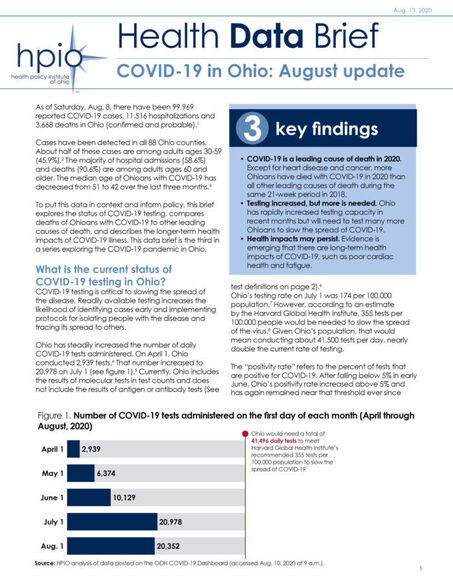COVID-19 in Ohio:
August update
As of Saturday, Aug. 8, there have been 99,969 reported COVID-19 cases, 11,516 hospitalizations and 3,668 deaths in Ohio (confirmed and probable).
Cases have been detected in all 88 Ohio counties. About half of these cases are among adults ages 30-59 (45.9%). The majority of hospital admissions (58.6%) and deaths (90.6%) are among adults ages 60 and older. The median age of Ohioans with COVID-19 has decreased from 51 to 42 over the last three months.
To put this data in context and inform policy, this brief explores the status of COVID-19 testing, compares deaths of Ohioans with COVID-19 to other leading causes of death, and describes the longer-term health impacts of COVID-19 illness. This data brief is the third in a series exploring the COVID-19 pandemic in Ohio.
Publication graphics
3 Key Findings for Policymakers
- COVID-19 is a leading cause of death in 2020. Except for heart disease and cancer, more Ohioans have died with COVID-19 in 2020 than all other leading causes of death during the same 21-week period in 2018.
- Testing increased, but more is needed. Ohio has rapidly increased testing capacity in recent months but will need to test many more Ohioans to slow the spread of COVID-19.
- Health impacts may persist. Evidence is emerging that there are long-term health impacts of COVID-19, such as poor cardiac health and fatigue.
From data to action
The long-term health impacts of this pandemic are daunting. Many organizations have issued analysis and evidence-informed recommendations for mitigating the spread of this virus.
Links to these resources are posted on the HPIO’s Coronavirus (COVID-19) in Ohio resource page. The Governor’s COVID-19 Minority Health Strike Force has issued an Interim Report, with immediate action steps to reduce COVID-19 disparities, and will soon release a blueprint for addressing the systemic issues that drive these disparities. In addition, Ohio’s 2020-2022 State Health Improvement Plan provides a menu of strategies that can be implemented at the state and local levels to improve overall health, better positioning Ohio to respond to this and future health crises.
As state and local policymakers make difficult decisions to address the fallout of COVID-19, it is important to acknowledge that this is a rapidly evolving crisis with new knowledge emerging daily. Addressing the pandemic’s many economic, social and health consequences requires accurate data, action based on the best available research evidence and strong collaboration between state and local-level partners across the public and private sectors.

